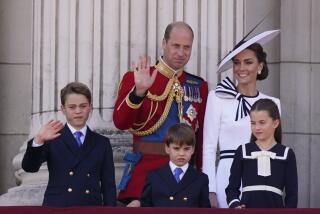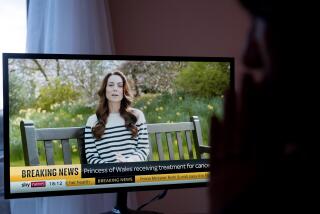A Fairy Tale Ends for Di and Charles
LONDON — Charles and Diana, prince and princess of Wales and heirs to the British throne, will formally separate after 11 years of what began as a fairy-tale marriage, Prime Minister John Major announced to Parliament on Wednesday.
Major told a subdued House of Commons that there are “no constitutional implications” to the separation and said the succession to the throne is unaffected. Both will continue to carry out official duties, he said.
For the record:
12:00 a.m. Dec. 11, 1992 For the Record
Los Angeles Times Friday December 11, 1992 Home Edition Part A Page 3 Column 1 Metro Desk 1 inches; 28 words Type of Material: Correction
Royal wedding--A story in Thursday’s Times about the marital separation of the Prince and Princess of Wales misstated the site of their wedding. They were married in London’s St. Paul’s Cathedral.
He also said that the couple has no plans for a divorce and will still share in the raising of their sons, William, 10, and Henry, 8. A Buckingham Palace spokesman added that there are no third parties involved.
Charles, 44, and Lady Diana Spencer, 31, were married at Westminster Abbey in July, 1981, in a glittering ceremony seen on worldwide television by an estimated 1 billion viewers. But within a few years, Britain’s voracious tabloid newspapers were pouncing on growing signs that the glamour and romance of the union had started to wear thin.
Former Prime Minister Edward Heath said in Commons that Major’s announcement was “one of the saddest in modern times.” No British prime minister has made a comparable announcement about royal marital relations since Stanley Baldwin announced in 1936 that Charles’ great uncle, King Edward VIII, was abdicating to marry American divorcee Wallis Warfield Simpson.
Firebrand leftist Labor member of Parliament Dennis Skinner suggested that the royal breakup might spell the end of the British monarchy because, on the issue of a proper succession, “we don’t know from time to time who they are.”
In fact, as Major indicated, Charles’ status as first in line to succeed his mother, Queen Elizabeth II, is unaffected by Wednesday’s announcement. William, referred to by the popular press as “the heir,” is next in line, followed by Henry, better known as Harry and jokingly referred to as “the spare.”
But figures less radical than Skinner were also questioning late Wednesday whether the ruling House of Windsor has much of a future, particularly if the couple get divorced.
Certainly friends of Diana say she has indicated that she will never be queen. She might well choose to remarry rather than spend the rest of her life as a legally separated married woman. She would lose all claim to the throne if she and Charles divorce.
And though there is nothing unconstitutional in having an officially separated couple on the throne, royalty experts suggest that, in practice, it would be a difficult arrangement.
Since word of the couple’s marital difficulties first became public, some royal watchers have speculated that Charles, tiring of the role of king-in-waiting, might eventually renounce the throne in favor of William. Queen Elizabeth II is 66 and has indicated she has no intention of abdicating.
The archbishop of York, Dr. John Hapgood, declared Wednesday that the separation does not affect Charles’ ability to assume the title of supreme governor of the Church of England when he ascends the throne. But experts said that could be called into question if Charles does obtain a divorce, and especially if he remarries.
In a year that the queen described in a recent speech as “horrible,” her only daughter, Princess Anne, was divorced from her husband, Mark Phillips. It was announced last week that Anne will be married Saturday in Scotland to Cmdr. Timothy Laurence, a navy officer and former royal aide.
The queen’s second son, Prince Andrew, Duke of York, was formally separated last March from his wife, the former Sarah Ferguson, popularly known as “Fergie.” That announcement came as news reports linked her romantically to two Texans, oil heir Steve Wyatt and financial consultant John Bryan.
In August, tabloid newspapers published sensational pictures of Bryan frolicking with a topless Duchess of York at a St. Tropez villa, in the south of France. A court in Nanterre, France, ruled Wednesday that photographer Daniel Angeli and his agency, Cogedipresse, had violated the couple’s privacy. It awarded a total of $132,000 to the couple; the duchess’ lawyer said her share would be donated to charity.
Then, on Nov. 20, one of the queen’s favorite residences, Windsor Castle, just west of London, was hit by a fire that resulted in millions of dollars in damage. The fire came at a time when the scandals about royal marriages and Britain’s harsh recession had called into question the queen’s tax-exempt status. Taxpayer unhappiness about the prospect of footing the repair bill at Windsor put Elizabeth, described as the wealthiest woman in the world, under even greater pressure.
Six days later, she announced that she and Prince Charles would pay taxes.
The royal family’s current low public esteem is in marked contrast to its high standing 11 years ago, when Charles and Diana entranced the country with news of their engagement.
The couple initially seemed an interesting, if contrasting, match--he 13 years her senior and a serious-minded ex-naval officer determined to learn how to be king; she beautiful, charming and outgoing. But soon it became clear that their tastes were decidedly different.
He favored classical music, older intellectual gurus, heavyweight books on history, days in the country, hunting, shooting, fishing, gardening and polo. She, on the other hand, liked pop music and parties, dancing and concerts, beach holidays, light romantic reading and friends in show business. Reports described her wandering Buckingham Palace with a Walkman clamped to her head playing Duran Duran and Dire Straits.
The first public sign that all was not well came when Prince Charles paid Diana only a perfunctory visit after the birth of their second son--and then went off to his polo ponies.
“From that moment, something inside me died,” she told friends, according to her unofficial biographer, Andrew Morton. Morton, in a book published this year, reported that Diana became increasingly unhappy, suffered the “slimmer’s disease,” bulimia, and possibly tried to kill herself.
NOT AVERAGE FAMILY: The royal rich are truly different from you and me. E1
More to Read
Sign up for Essential California
The most important California stories and recommendations in your inbox every morning.
You may occasionally receive promotional content from the Los Angeles Times.








